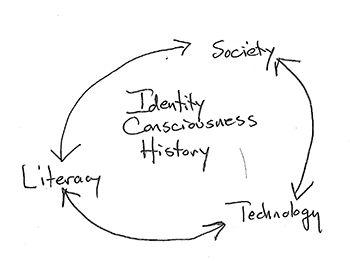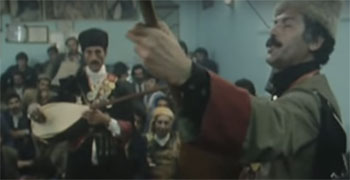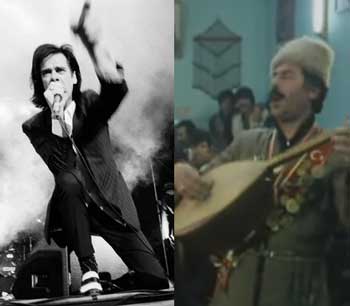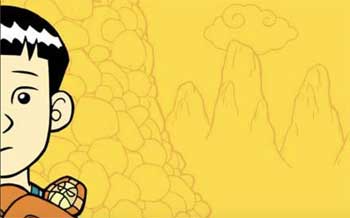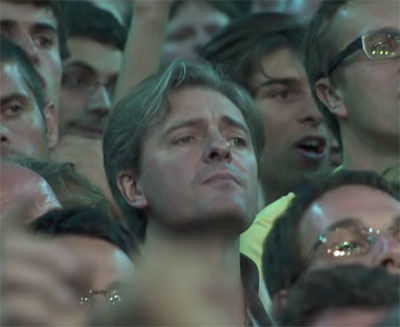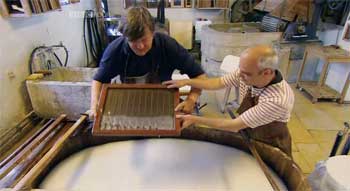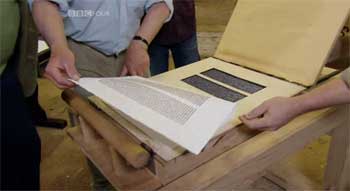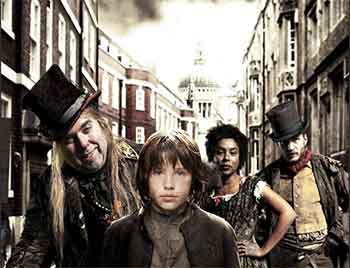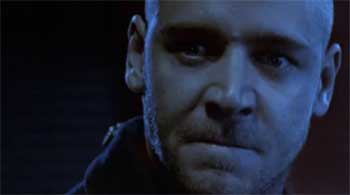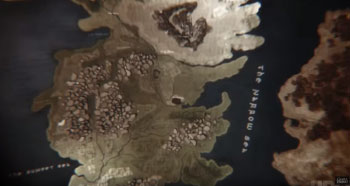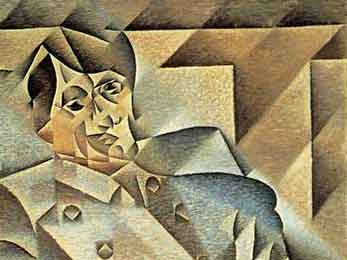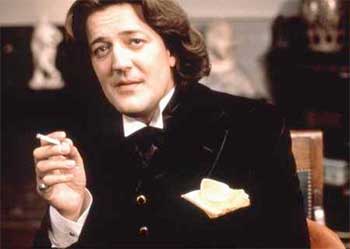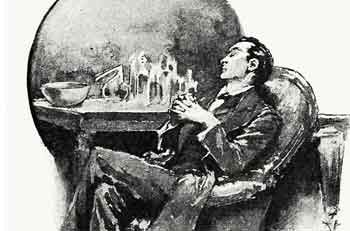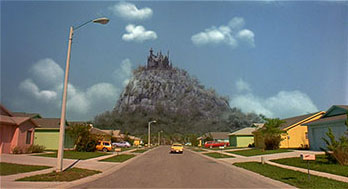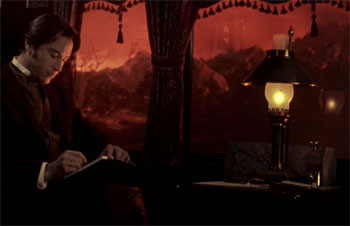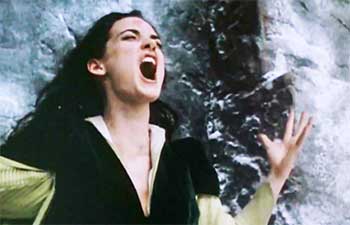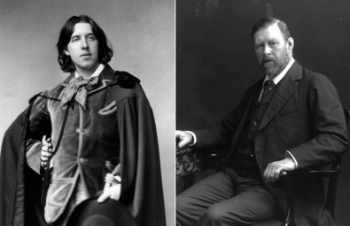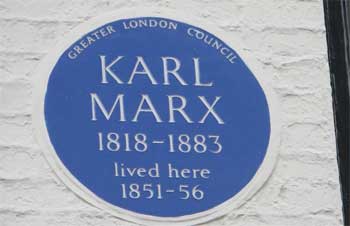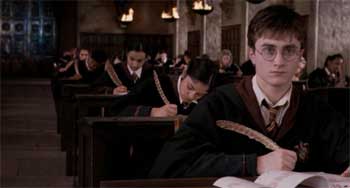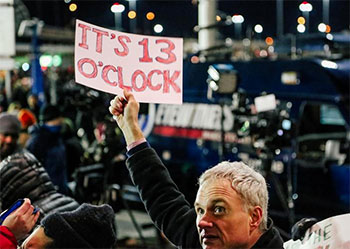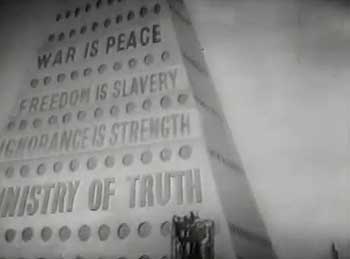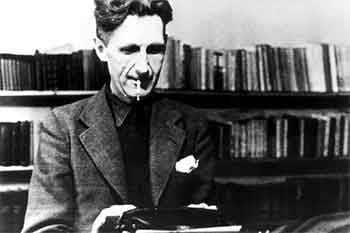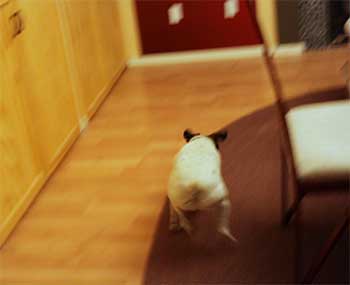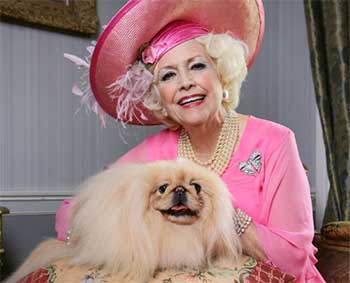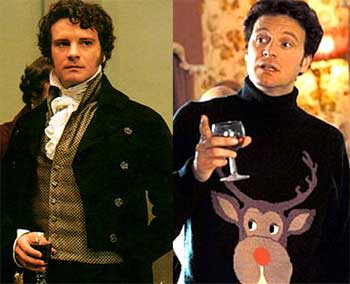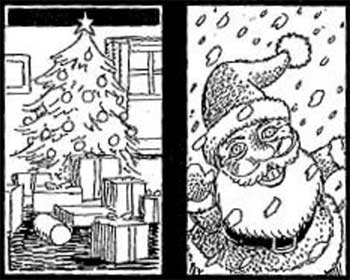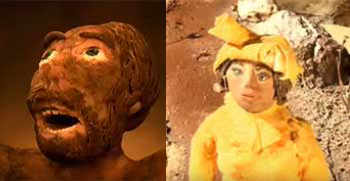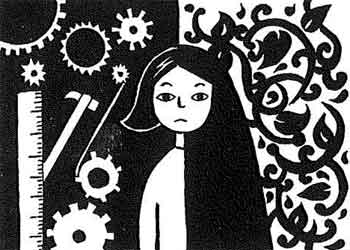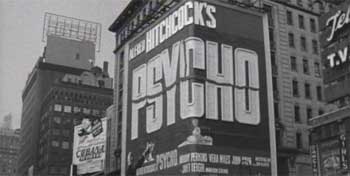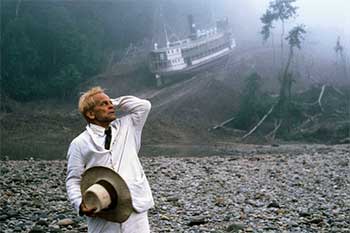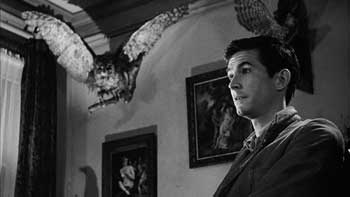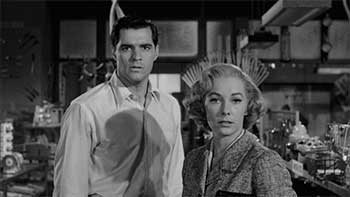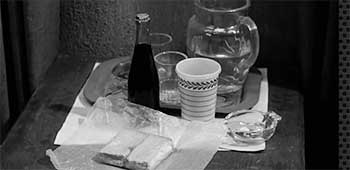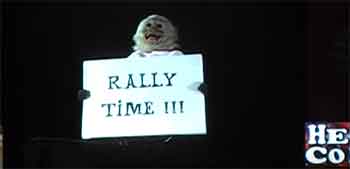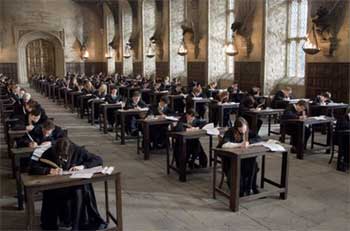Schedule | Spring 2018
Jump to Today | January | February | March | April | May| W 1/10 | Welcome to WRIT 1506!In this course, you will gain a broad historical perspective on the effects of writing and reading on the material, cultural, and political structures of society. In particular, we will learn how fundamentally various forms of literacy have influenced not only our ways of communicating, but our shared sense of reality and identity. For more, see the syllabus. |
Day 1. Introduction to Literacy, Technology, and SocietyTo what degree do peoples' senses of reality and self change because of technology?
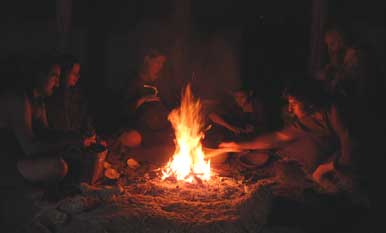
Literacy, Technology, SocietyTimeline and Phases of Society/Identity Terms to Remember
Resources
|
| F 1/12 | HomeworkRead and Be Prepared to AnswerRead, from Walter Ong's Orality and Literacy, the Introduction and Chapter 1 using the principles of Active Reading, and come in prepared to answer the Reading Questions concerning Chapter 1. Don't answer the questions on the handout in sentences and paragraphs, however. Instead, answer them in the margins of the book with word tags, arrows, stars--whatever symbols seems useful. Photocopy or Scan/Print and Bring inAfter you've read and marked your text, choose a two-page spread from the book that best shows your active reading and engagement with Ong and with one of more of the questions above. Photocopy (a.k.a., scan and print) that two-page spread, write your name in the upper right on the paper, and bring it to class next time to turn in. (1A)~ |
Day 2: Ong C1, The Orality of LanguageWhat does it mean (and why does it matter) that language is primarily oral? |
| WEEK 2 M 1/15 |
MLK Holiday: No Class Meeting |
|
| W 1/17 | HomeworkRead and Be Prepared to AnswerRead Walter Ong's Chapter 2, pages 16-30. After using the principles of Active Reading to mark your text, come in prepared to answer the Reading Questions for Ong's Chapter 2. Don't answer the questions on the handout in sentences and paragraphs, however. Instead, answer them in the margins of the book with word tags, arrows, stars--whatever symbols seem useful. Log Your Classroom ContributionsIn replies to the the Moodle forum "Classroom Contributions," please make note of any quotations from the readings which you orally raised and commented on in class last time. Please log only quotations that you contributed to discussion out loud. Post one message for each quotation using the format of this example: M 3/14: Orwell, The Labyrinthine World of Doublethink This format of each message includes:
|
Day 3: Ong C2, The Discovery of Primary OralityHow does knowledge of ancient oral cultures help us understand our own written culture?
|
| F 1/19 | HomeworkRead and MarkRead Ong's Chapter 3, "Psychodynamics of Orality" and come in prepared to answer the Reading Questions for Chapter 3 Answer The Reading Questions in Writing (and Bring on Paper)Answer each of these questions in writing: a paragraph, a list, a chart, or map, etc. Make your answer "thing-like" (Ong 11), and be sure the "thing" specifically refers to particular pages and passages in Ong's Chapter 3. (2A) If you are interested in alternative formats to conventional writing, here's a sample of one. (2A) Log Your Classroom ContributionsIn replies to the the Moodle forum "Classroom Contributions," please make note of any quotations from the readings which you orally raised and commented on in class last time. Please log only quotations that you contributed to discussion out loud. Post one message for each quotation using the format of this example: M 3/14: Orwell, The Labyrinthine World of Doublethink This format of each message includes:
|
Day 4: Ong C3 Psychodynamics of OralityWhat are some specific ways that oral and written forms of culture and consciousness differ?
Psychodynamics of Orality A 38-Year-Old Wheat Farmer
|
| WEEK 3 M 1/22 |
HomeworkPrepare for WednesdayIn addition to doing the reading, you will write and turn in a two-page, formal piece of writing on Wednesday. Use the time over the weekend and early this week to prepare both the reading and writng. |
Day 5: Gene Luen Yang on Comics
Special Event: Meet in the Library RotundaWe will meet as a class in the Library Rotunda to hear (and see) a talk by Gene Luen Yang about comics. We will be studying visual literacies (including graphic novels and comics) later in the semester. This is not an optional meeting. This is a meeting of the class. I will ask you please to check in with me at the event so I can be sure you are counted on the roll and not marked absent. |
W 1/24
|
Homework DueRead and MarkRead "Ong Chapter 4 "Writing Restructures Consciousness." Mark and, using the techniques of Active Reading, make marginal notes, especially with the question below in mind. When you get to Ong's discussion of Plato, read over the passage "from Plato's Phaedrus" on the handout I gave you in class. See if you can find in Plato's passage (from an imagined dialogue between Socrates and Phaedrus) the attitudes and ideas about writing which Ong attributes to Plato. Write, Print, and BringWrite a 500-word "Preparation Sheet" titled "Ong Chapter 4" which answers the following question:
This preparation sheet should
BringBring your Ong book and be sure you have the handout "from Plato's Phaedrus" Log Your Classroom ContributionsIn replies to the the Moodle forum "Classroom Contributions," please make note of any quotations from the readings which you orally raised and commented on in class last time. Please log only quotations that you contributed to discussion out loud. Post one message for each quotation using the format of this example: M 3/14: Orwell, The Labyrinthine World of Doublethink This format of each message includes:
|
Day 6: Ong C4
How does writing really restructure conscousness?Resources
|
F 1/26
|
Homework DueBring the Ong BookPlease bring your Walter Ong book to class Moodle Posting (by noon)Set-UpIn the Walter Ong book, we've read about the deep and varied changes, from 800 BC onward, which literacy brought to society, identity, the sense of history, the nature of consciousness, etc. With the handout, "Jay David Bolter: The Cathedral and the Book", we thought a little about the changes wrought by a different revolution: the explosive rise of printing starting in the 1440s AD. Consider these statistics: in the 59 years between 1440 and 1499,
Since we as a class know very little about the historical effects of printing at this point, let's try to use what we know about revolution in literacy (from the Ong chapters) to conceive of a question about the consequences of the revolutionary rise of print in some particular aspect of society, identity, history, consciousness, etc. What to Post (by noon today)In a reply to the Moodle forum "The Print Revolution," write a question that speculates on the possible effects of the print revolution starting in 1440. Be sure your question focuses on some particular aspect of society, identity, history, consciousness as suggested by either Ong or Bolter. Include in your question what idea or passage from Ong or Bolter suggested the basis of your question (with page number if it comes from Ong). You do not necessarily need to know the answer. The point is to pose a thought-provoking and possibly productive question for exploring the some specific effect of print as a social and cultural phenomenon. ExampleOng observes that literacy changed the individual's very means of conceiving of him or her self (54). Did the rise of print provide new means of conceiving and describing the individual self? (3B)~ Log Your Classroom ContributionsIn replies to the the Moodle forum "Classroom Contributions," please make note of any quotations from the readings which you orally raised and commented on in class last time. See the full directions on the syllabus. |
Day 7. The Machine that Made Us 1(Gutenberg's Press)
|
WEEK 4
|
Homework DueThe Print RevolutionIn the Moodle forum "The Print Revolutioin," you asked questions about the long-term consequences of the explosive rise of printing in the 15th century. 1. Look OverRead over the questions that you and your classmates posed about print culture. 2. Read CarefullyFor answers, read Walter Ong's Chapter 5, "Print, Space, Closure, " pages 115-135. Use the principles of Active Reading (new version!) to mark your text and leave a record of your reading experience. 3. Post to MoodleChoose two questions to answer in a replies to those messages. In each reply, write a substantive paragraph which includes at least two quotations, with page numbers, from Ong (at least one of those quotations from Chapter 5). In your paragraphs, also mention some scene, detail, statement, or fact from the documentary The Machine That Made Us. Note that Ong may not directly answer your classmates' questions or speak specifically to their topics, but the context and analysis Ong provides might enable you to make an informed argument about the nature and effects of print culture. (4A)~ 4. PrintPrint the two questions and your paragraphs and bring them on paper to class for use in discussion. (No laptops or devices.) Bring your Ong BookPlease bring your Ong book to class again today. |
Day 8. The Machine That Made Us 2
What results from the Print Revolution?Takes Notes on the DocumentaryIn class today, take notes on the following topics: 1. How the documentary speaks to the questions you asked and answered in the Moodle forum. (On your printout, please circle key ideas, terms, or concerns.) 2. How the documentary describes the "society" of the printing press:
|
| W 1/31 | Homework DueReadPaul Cobley, Narrative, Chapter 1 "In the Beginning, The End," pages 1-27. Use the principles and techniques of Active Reading to mark your text and record (externalize!) your reading experience. Reading Question: Cobley argues that the power of narratives comes not simply from their content, but from their form: that is, not the story itself, but the telling of the story. This power of narrative telling, Cobley says, is fundamental to human experience and consciousness. This means that the concept of "narrative" much more than just a way of organizing a piece of writing. Choose three specific, key quotations from Cobley's chapter which suggest the source, nature, and/OR consequences of this narrative as a powerful principle in society, culture, and history. Come to class prepared to read and explain your choices. Bring your Ong BookPlease bring your Ong book to class again today. |
Day 9:
Narrative and Consciousness
|
February
| F 2/2 |
Homework DueRead Cobley Chapter 3Read Cobley, Chapter 3 "The Rise and Rise of the Novel" using the techniques of Active Reading. Reading Question:Cobley argues that how you choose to tell a story creates a "problem of representation" and a potential crisis of social authority. Identify three passages (with page numbers) from the chapter that suggest why the telling of a story has such an effect on the story's meaning and consequence. Post In Moodle (Before noon)Choose one of those passages and, in a reply to the Moodle forum, "Cobley C3,"
Write down or printout a copy of your answer and bring it to refer to in class. (4B)~ Log Your Classroom ContributionsIn replies to the the Moodle forum "Classroom Contributions," please make note of any quotations from the readings which you orally raised and commented on in class last time. See the full directions on the syllabus. Notes on the "Most Answered" HandoutHow does "The Machine that Made Us" speak to the concerns posed in the "Most Answered Questons" from the "Print Revolution" posts? |
Day 10: The Problems of Representation (Cobley C3) |
| WEEK 5 M 2/5 |
Homework Due1. Read Cobley Chapter 4Read Cobley, Chapter 4, "Realism" using the techniques of Active Reading. 2. Reading Activities1. Make a ListAccording to Cobley,
Make a list of at least four characteristics with page numbers. 2. Three Quotations that Challenge the Realist SolutionConventionally, "realistic" representation is assumed to be objective, scientific, and apolitical. This idea presumes to solve the problems of representation. Throughout this chapter, however, Cobley argues otherwise: that realism represents another style of representation, rather than offering unmediated access to reality. Identify at least three of Cobley's reasons, ideas, examples, or arguments (with page numbers) that show how realist narrative is not pure or uncontroversial in its representation of reality or truth. 3. Post In MoodleChoose one of those passages and, in a reply to the Moodle forum, "Cobley C4,"
Write down or printout a copy of your answer and bring it to refer to in class. (5A) 4. Another Response to "Print Revolution"Let's have another try at the "Print Revolution" forum.
5. Log Your Classroom ContributionsIn replies to the the Moodle forum "Classroom Contributions," please make note of any quotations from the readings which you orally raised and commented on in class last time. See the full directions on the syllabus. 6. Look over HandoutsLook over the handouts Exam Capacities and Exam Format and bring in any questions you have. |
Day 11: Cobley C4, RealismWhat is realism, and how is it not a solution to the problems of representation?Resources:
|
| W 2/7 | Homework DueReadRead Cobley Chapter 5, "Beyond Realism" Reading Question (3 Passages):In Chapter 4, Cobley argued--citing Terry Eagleton--the 19th and 20th centuries saw a transformation in the scale of economic life (i.e., "capitalism") through three phases (88). These phases had profound effects on both the form and focus of narratives, and on contemporary models of individualism or identity. In Chapter 5, Cobley is describing the last phase of economic development: the global or "imperialist" stage. Identity at least three passages or examples from Chapter 5 that demonstrate the characteristics of this third phase, and how those characteristics resulted in "modernist" narrative style and a "modernist" identity. In a reply to the Moodle forum "Cobley C5" (by 11 a.m.), give the page number, a brief quotation, and two or three sentences of explanation for each of your choices. Bring your reponses (or at least notes about them) to class on paper. (5C)~ Log Your Classroom ContributionsIn replies to the the Moodle forum "Classroom Contributions," please make note of any quotations from the readings which you orally raised and commented on in class last time. See the full directions on the syllabus. |
Day 12: Cobley C5 (Global Modernism)
How are economic, technological, and political developments in the 20th century tied to the rise of modernist of art, literature, and models of identity?Resources:
|
| F 2/9 | Homework1. Bring Your Cobley Book to Class
|
Day 13: Picture of Dorian Gray 1:
Resources
|
| WEEK 6 M 2/12 |
Homework Due1. Make Notes on the Gothic HandoutRead over the handout "Notes on the Gothic Genre" read carefully. Mark anything you don't understand to ask about next time. In the left margin of the handout, make notes about the following: What aspects of The Picture of Dorian Gray exemplify any of these characteristics of the Gothic? Bring your handout to class, ready to discuss your observations and ask your questions. 2. Finish Reading The Picture of Dorian Gray
|
Day 14: Picture of Dorian Gray 2
|
| W 2/14 | Homework Due1. Read in Dracula
2. Bring your Copy of The Picture of Dorian Gray
|
Day 15: Dracula 1
How does Stoker's representation and juxtaposition of old and new societies contribute to the meanings of Dracula?Ong's 9 Psychodynamics of Orality v Literacy
|
| F 2/16 | Homework Due1. ReadRead Dracula pages 95 - 215 (Chapters 6- 13) 2. Make Notes on the Gothic HandoutYou will remember that you made notes in the left margin of the handout "Notes on the Gothic Genre" with details from The Picture of Dorian Gray which exemplified the genre's characteristics. Now, make notes in the right margin with details and examples from Dracula that illustrate the same Gothic characteristics. 3. Make Notes in the Novel's MarginsAs you read, make notes in your margins concerning the following three topics: Gender and SexualityIn what ways does the novel define, affirm, transform, or transgress roles of gender and standards of sexuality? Use the norms suggested by the text itself to determine what is transformational or transgressive. Information Technologies and Knowledge WorkNotice that the narrative of Dracula is composed of documents, rather than the voice of a single narrator. This way of telling the story highlights the role of information technologies: letters, journals written in short hand, phonographs, typewriting, etc. How is the handling of information and knowledge critical to the batte again Dracula? In what ways is this the story of a team of what today we would dall “knowledge workers.” 4. Four Quotation Tags and Talking Points (Bring on Paper)Under a heading for each these two topics, write at least one quotation tag (1-5 words and a page number with tenths) for a relevant, revealing and interesting passage. For either of the topics of your choice, add at least 2 more passages for a total of (at least) 4. Under the column of three tags, write down some talking points for yourself to explain the relevance and significance of you chosen of passage to explaining Stoker's representation that of that idea in Dracula. Be prepared to turn these notes in at the end of class today. (6A)~ 5. Log Your Classroom ContributionsIn replies to the the Moodle forum "Classroom Contributions," please make note of any quotations from the readings which you orally raised and commented on in class last time. See the full directions on the syllabus.
|
Day 16: Dracula 2
How is Dracula and "anxious" book, and what is it anxious about?Resources |
| WEEK 7 M 2/19 |
Homework Due1. Social Anxieties and Social Order (5 Quotation Tags)As the "Introducton" observes, citing Geoffry Wall, Dracula is "persistently, an anxious book" (15). As you read, choose one element (for instance, one character, particular conflict, idea, word, theme, etc. to track as you read. Make a list of at least 5 quotation tags to illustrate how your chosen element relates to this persistent anxiety in Dracula, and to more clearly define what this anxiety is about (beyond the obvious plot). In other words, how is this anxiety not simply about something obvious and literal like "being scared of a vampire," but is also about social, psychological, historical, political, or cultural problems/challenges to the social order beyond the book itself. In your quotations, look carefully at Stoker's wording and plotting to see
Beneath the list of quotation tags, write 2 or 3 sentences to clarify how you see Stoker using your chosen element to make these anxieties meaningful beyond the aesthetic experience of reading. Bring your notes on paper to class and be prepared to turn them in. Don't worry if your notes are not in a form or style that anyone else will understand. (7A) 2. ReadRead Dracula pages 216 - 299 (Chapters 14 - 19) 3. Continue Notes on the Gothic HandoutOn the handout "Notes on the Gothic Genre," continue to make notes in the right margin with details and examples from Dracula that illustrate the same Gothic characteristics. (7B) 4. Log Your Classroom ContributionsIn replies to the the Moodle forum "Classroom Contributions," please make note of any quotations from the readings which you orally raised and commented on in class last time. See the full directions on the syllabus. |
Day 17: Dracula 3
How do the Gothic elements of Dracula help give meaning to its "persistently anxious" tone?Resources
|
| W 2/21 | Homework DueReadRead Dracula pages 300 - 419 (Chapters 20 - 27) Literacy, Technology, and/or Society in Dracula (Moodle and Print)Post the following to the Moodle Forum, "Literacy, Technology, or Society in Dracula" by noon today. Choose a passage from Dracula and use it to analyze how Stoker's presents literacy, technology, or society as a theme in Dracula. 1. Start by choosing a character or plot event in the novel, which seems to feature literacy, technology, or society as a theme. 2. Look closely at Stoker's language in some passages from the novel which represent what happens to that character, what the character does, or how the plot event unfolds. 3. In a substantial paragraph in which you quote from Dracula to describe what you see Stoker saying about the
Be sure to quote from the novel at least twice in your paragraph, and to do a "close reading" of the language of those quotations in your own analysis. Print out your Moodle posting to refer to in class and to turn in at the end. (7C)~ |
Day 18: Dracula 4
What ideas about literacy, technology and society can we draw from Dracula?Resources
|
F 2/23 |
Homework DueBring Dracula and Cobley BooksMarxPrint, number the paragraphs, and read Karl Marx's "Preface" to A Contribution to the Critique of Political Economy (starting with the fourth paragraph, which begins "Although I studied jurisprudence,....") Annotate the "Base and Superstructure" Handout with Quotation TagsAs you read the Marx piece, select and arrange six or seven key quotations from the reading (each represented by a "quotation tag" composed of the paragraph number and a few keys words) on the Base and Superstructure diagram. With your placement of these quotation tags on the diagram, you're indicating which quotations show Marx talking about:
For example, you would place a quotation about the "means of production" in the base, or a quotation about education in the superstructure. (You might need write your paragraph numbers and key words arround the edges and use arrows to show where they go in the diagram) Bring your handout to class prepared to turn it in at the end of the meeting. (7D)~ |
Day 19: Marx
What is historical materialism, and how does it inform analyses of society, culture, history, and literature?Resources
Marxist Theorists and Scholars in Cobley
|
| WEEK 8 M 2/26 |
Homework DueLog Your Classroom ContributionsIn replies to the the Moodle forum "Classroom Contributions," please make note of any quotations from the readings which you orally raised and commented on in class last time. See the full directions on the syllabus. Write and Post 5 Questions for the ExamWrite an exam question for each of kinds of knowledge covered on the exam. You can use any of the three question formats for any of the capacities. See the handout: Exam Capacities (6) The Format of the QuestionsWrite each of those questions in your choice of three formats:
By noon today, post your questions to the appropriate Moodle forums in the section "Midterm Exam." (8A)~ Bring to ClassBring to class all books, handouts, and notes from the first half of the course. Page Numbers on Your HandoutsSee the list of handouts on the page Handouts and Assignments, and copy the page numbering from this list onto your copies of the handouts. (Note that only the front side of the handouts is numbered.) Put them in numerical order so you will be able to find them easily in class
|
Day 20: Midterm Exam Preparation |
| T 2/27 - W 2/28 |
Take-Home Portion of the Midterm (Tues-Wed)Take-Home Portion of the Midterm
|
|
| W 2/28 | Homework Due
|
Day 21: Midterm Exam: In-Class Portion
|
| F 3/2 | Homework DueMoodle Post: "Week 8 Linchpin"With the passing of the Midterm Exam in Week 8, and the advent of Spring Break, we take a breath here at the mid-way point. Before you leave for the break, sit down and do the following:
|
No Class Meeting
|
| M 3/5 | Spring Break |
|
| W 3/7 | Spring Break |
|
| F 3/9 | Spring Break |
|
| WEEK 9 M 3/12 |
Homework DueReadRead Cobley C6: "Modernism and Cinema" pages 132 - 154. Before you do, though, be sure to see the directions below: Cluster for Answers and PatternsAs you read the Cobley chapter, look for at least 8 passages or phrases that help you answer the questions below. Compose "quotation tags" (1-5 words and a page number with tenths) for those passages on a sheet of paper in the form of a cluster. Read carefully my directions for clustering. Be sure to follow each step, especially the final one. Choose quotations that speak to the questions below, but also use the clustering technique to look for patterns and relationships that you might not otherwise notice or think about. Questions to Be Thinking About Making Your Cluster1. According to Cobley, what are the features of modernist narrative (for instance, how does it differ from realist or Romantic narrative)? 2. What are the features of a modernist self or identity, according to Cobley? 3. In what ways does Cobley say that cinematic narrative differs from print narrative? What are some of cinematic narrative's features and techniques? 4. According to Cobley, what are some ways that cinema naturally expresses modernist ideas and attitudes? (9A)~ Consider Adding Tags from Cobley's Chapter 5Cobley's Chapter 5, "Beyond Realism" is also about Modernism. Consider adding to your cluster several tags of passages you marked in Chapter 5 as important or interesting to give you a fuller picture of Modernism. Be sure to include page numbers. |
Day 22: Cobley C6 Modernism and Cinema
How does the modernist idea of the self (identity) shape modernist narrative (literacy)?
|
| W 3/14 | Homework DueReadRead 1984, pages 1-81 Write a Paragraph Using 3 Quotations -- What are some ways that the government controls society in 1984? Identify three quotations that help describe these methods of tyranny and their effects. Write a long paragraph that uses the three quotations to answer the questions. Print the paragraph and bring it to class. (9B)~ Log Your Classroom ContributionsIn replies to the the Moodle forum "Classroom Contributions," please make note of any quotations from the readings which you orally raised and commented on in class last time. See the full directions on the syllabus.
|
Day 23: Orwell's 1984 1 (Techniques of Tyranny)
How does 1984 represent and critique the operations of tyranny?Resources
|
| F 3/16 | Homework DueReadRead 1984, pages 81 - 156 Bring Your Cobley BookLook at and Bring the Handout "Resistance to Modernity"
Five Quotation Tags on a HandoutAs you read this section of 1984, have your Modernism handout at your side. Print it out if you don't have it on paper. 1. Look over the quotations, characteristics, causes, and conditions our Modernism handout. 2. Consider these two questions:
3. As you read, note down the location of at least five quotations from 1984 which suggest answers to these questions. 4. In the margin of the handout, write quotation tags (a few key words and the page number with tenths) for each passage from 1984, and then draw a line to connect the tag with the point about modernism. 5. Bring the handout to class. Write and Print a ParagraphThink about the connections between 1984 and modernism that you've made on the handout. Write and print out a paragraph that analyzes these connections between modernism and 1984, showing how Orwell's novel:
(9C)~ Log Your Classroom ContributionsIn replies to the the Moodle forum "Classroom Contributions," please make note of any quotations from the readings which you orally raised and commented on in class last time. See the full directions on the syllabus. |
Day 24: Orwell's 1984 2 (Modernism)In what ways is 1984 a modernist novel?
|
| WEEK 10 M 3/19 |
Homework DueReadRead 1984, pages 156 - 218 What Went Wrong With History?In the dystopian world of 1984, it is more than just one society that has gone wrong. The very process of history itself has been halted. Progress is impossible because change is not possible. History has stopped. Choose a passage from 1984 that seems to demonstrate or comment on how the historical process is stuck or frozen. Look back to some of our previous readings and discussions that concerned the process of history:
Cluster to Find PerspectivesOn a piece of paper, start a cluster with a quotation tag for your chosen passage at the center. (See my explanation of clustering as an analytical technique.) With your cluster, try relating at least 5 key ideas, terms, quotations from the theorists above to your passage from 1984. Add quotation tags for more passages from 1984 as they occur to you. In a few extra items on the cluster, add a few words and phrases of your own to help show how the 5 quotations give us words and ideas to interpret "what went wrong with history" in the world of 1984. Bring the cluster to class. (10A)~ Bring Your Cobley Book
|
Day 25. Orwell's 1984.3: Modernism; What Went Wrong with History?
How might 1984 illustrate models or theories of history from our previous readings?How can our previous readings help us describe what went wrong with history in the world of 1984?Resources
|
| W 3/21 | Homework DueLog Your Classroom ContributionsIn replies to the the Moodle forum "Classroom Contributions," please make note of any quotations from the readings which you orally raised and commented on in class last time. See the full directions on the syllabus. ReadRead 1984, pages 218 - 298 Love and Identity in 1984The conflict between the individual self and the social order is a characteristically modernist theme. One way an author like Orwell can present an individual self like Winston or Julia is through the idea of love. Orwell represents many kinds of love in 1984: brotherly, motherly, fatherly, romantic, sexual, marital, patriotic.... Are there others? Make a list of at least 5 examples or passages where Orwell represents or talks about love, in one form or another, in 1984. Note down the page numbers with tenths and a few key words from the quotation (a quotation tag). Write a ParagraphWrite a paragraph in which you quote and analyze at least two of the passages you found to
(10B)~ |
Day 26: 1984 4 (Love and Identity)
In the world of 1984, how does love contribute to Winston's sense of identity?Resources
|
| F 3/23 | Homework DueReadCobley, Chapter 7 "Postmodernism" Annotate the Postmodernism HandoutI gave you a copy of the handout, "Postmodernism," which distills and summarizies six characterics of postmodernism (mostly drawn from Cobley). Annotate your paper copy of the handout with 12 quotation tags (2 per characteristic, on average) pointing to particular statement or examples in Cobley's chapter. Then, for each of the six characteristics, write a sentence or two on your handout that clarifies how the quotations illuminate, add to, or enrich your understanding of each of the handout's summaries. Bring your handout to class with your name on it. (10C)~
|
Day 27: Cobley C7 Postmodernity"Real Dogs Have Fun, Generally Inside"
What is the nature of postmodernity and postmodernism?Resources
|
| WEEK 11 M 3/26 |
Homework DueRead (About) Hayden White1. From the Cobley book, look up Hayden White in the index and then read the pages analyzing how White fits into Cobley's survey of narrative theory. 2. From Moodle, download, print, read, mark and bring to class
See the Moodle site for links to these PDFs. Come With Answers to These Thought Questions
|
Day 28: Hayden White's Postmodern History and Historiography
How do the tools of writing history affect the history we have?Resources
|
| W 3/28 | Homework DueRead Bridget Jones' DiaryPages 1 -74 Postmodern Satire1984 and Bridget Jones' DiaryStrangely enough, both 1984 and Bridget Jones' Diary are satires. They were both also chosen by readers of the prestigeous British newspaper The Guardian as two of the 10 Books That Defined the Twenieth Century. If 1984 (published in 1949) is modernist in both the world it represents and the ways it represents it, could we say that Bridget Jones' Diary (published in 1996) is postmodern in subject and style? In what ways are postmodern ideas, attitudes, and assumptions expressed in Fieldings's development of characters and her humor? Notes on Your Handout:Add at least 8 tags to your Postmodernity handout from or about Bridget Jones' Diary. These items can be either of the following: 1. Particular LinesMake notes in the margins of your Postmodernity handout (or print out a new one if you need more room), connecting particular lines or details from BJD to specific items on the handout (both in the "Charactersitcs" column and the "Causes and Conditions" column). 2. General Themes and FormsAlso try stepping back: are there general aspects of the book that you can associate with postmodernism? For instance, the diary format, the voice, the language, ongoing themes, plot lines, etc. On your handout, connect these general observations to particular ideas about postmodernism, and then try to find a particular instance that you can point to on a particular page. Log Your Classroom ContributionsIn replies to the the Moodle forum "Classroom Contributions," please make note of any quotations from the readings which you orally raised and commented on in class last time. See the full directions on the syllabus. Re-Read Ong about DiariesRe-Read what Walter Ong has to say about diaries on pages 100-101. -- What does it make you think about in regard to Bridget Jones' Diary? Bring your Ong book to class. |
Day 29: Bridget Jones' Diary 1
How is Bridget Jones' Diary postmodern?
|
| F 3/30 | Homework DueRead Bridget Jones' DiaryPages 75-195 Thought Questions:
|
Day 30: Bridget Jones' Diary 2No Class Meeting
How does Fielding represent information technologies in the world of Bridget Jones?Resources
|
| WEEK 12 M 4/2 |
Homework DueRead Bridget Jones' DiaryPages 196 - 271 Memorize the 5 Characteristics of PosmodernismTry using the mnemonic nonsense phrase "Real Dogs Have Fun, Mostly Inside" (RDHFMI). See the Postmodernism handout. 1984 and Bridget Jones' Diary1. The Set-UpReaders of the prestigeous British newspaper The Guardian chose 1984 and Bridget Jones' Diary as two of the 10 Books That Defined the Twenieth Century. The two novels, however, come from very different ends of the century: Orwell's from the 1940s and Fielding's from the '90s. Comparing and contrasting the two novels distinguishes two very different modes of "society" (one of our course's key words): modes we might call
2. A Three-Column ComparisonOpen the Word file "Three-Column Comparison." In the middle column, fill in vertically at least eight terms that could be used to compare 1984 and Bridget Jones Diary. Here, for instance, are 17 you might choose from:
In the left column labeled, "1984," write a few words that characterize Orwell's representation of that theme or type in 1984. You might list an example or two from the novel as well. In the right column labeled, "Bridget Jones' Diary," do the same: type in examples and characterizations of how that theme or type is represented by Fielding. 12A~ 3. Rank Your Top 3 and Have Page NumbersWhich points of comparison best illustrate the differences between modernist and postmodernist modes of society? of consciousness? Rank your top three and be ready to discuss why. What passages from Bridget Jones Diary best illustrate the postmodern, '90s side of your top three differences? Have page numbers for each of the three Log Your Classroom ContributionsIn replies to the the Moodle forum "Classroom Contributions," please make note of any quotations from the readings which you orally raised and commented on in class last time. See the full directions on the syllabus. |
Day 31: Bridget Jones' Diary 3
How do modernism and postmodernism differ as responses to the conditions of modernity?Resources
|
| W 4/4 | Homework Due1. Print, Read, and Make Notes OnPrint, read, and annotate Chapters 2 and 3 of Scott McCloud's Understanding Comics" available from the Moodle site. CommentMcCloud's Chapter 2 provides an introduction to "visual styles." McCloud's point is that the choice of style is not a matter of mere decoration, but fundamental to how an images means. The climax of the chapter is McCloud's monumental, two-page diagram on pages 52-53, which probably won't make much sense until you've actually read the chapter before and after the diagram. 2. Two Explanatory Panels (Chapter 2)First, choose two panels from the chapter that could help us understand all that's going on in that key diagram on pages 52-53. Come to class prepared to point to those panels and relate them to some aspect of the big diagram to help explain it. Refer to your panels by page, row, and panel numbers: for instance, page 12, row 2, panel 2. 3. Memorize the Six Transition Types (Chapter 3)1. Memorize McCloud's 6 Types of panel-to-panel transitions. (You might come up with a mnemonic nonsense phrase if it helps to recall the first letters of tbe transition types.) 4. Write a ParagraphBut so what? In what ways does the rest of McCloud's Chapter 3 make clear why these transitions are profoundly significant in understanding how the visual literacy of "sequential art-forms" like comics work on readers and viewers? Choose two or three terms, examples, or panels from Chapter 3 which answer the question above, and use them in a paragraph of explanation. Be sure to cite McCloud using just the page number. 12B~ 5. Log Your Classroom ContributionsIn replies to the the Moodle forum "Classroom Contributions," please make note of any quotations from the readings which you orally raised and commented on in class last time. See the full directions on the syllabus. |
Day 32: Scott McCloud Understanding Comics C2 and C3:Visual Styles and Transitions
Is "Visual Literacy" really literacy?Resources
|
F 4/6 |
Homework Due1. Print, Read, and Make NotesPrint, read, and annotate Chapters 4 and 6 of Scott McCloud's Understanding Comics" available from the Moodle site. 2. Moodle Forum Posting (C4)In a reply to the Moodle forum "McCloud's C4: Time Frames," use ideas and examples from McCloud's Chapter 4 to analyze how an image that you've found frames time. The image might be a panel of a drawn comic, a photograph, a still shot from a film, a piece of art, etc. 1. Download or scan a copy of your chosen image so you have it as a digital file. 2. In a reply to the opening message of the Moodle forum, type a title for your message. 3. insert the digital file of your image into your Moodle post: Scroll down in the "Your Reply" screen of Moodle (after you click "Reply" to my message at the of the forum), and find the "Attachment" section with an window labeled "Drop Files Here to Upload." Drag your screen-shot image file from where it is saved and into this box. 4. From the PDF of McCloud's Chapter 4, take a screen shot of a panel (or perhaps a set of panels) which suggest language and ideas for analyzing the framing of time in your chosen image (Step 1). 5. Write a paragraph in the Moodle post which applies the ideas and examples from McCloud to an analysis of time in your image. 12C~ 3. Thought Question:
|
Day 33: Scott McCloud Understanding Comics C4 and C6
How can time play a role in the meaning of static images?What happens when verbal and visual literacies are used together?Resources
|
| WEEK 13 M 4/9 |
Homework DueHomework HolidayAs we catch up today, you won't have additional homework. However, before class please review and refresh yourself on the homework for last meeting, which we will discuss today. Also, you could use your holiday to get a head start on the homework below for next time. |
Day 34: Visual Literacy
Resources
|
| W 4/12 | Homework DueRead PersoplisRead the entirety of Perspolis: the Introduction and pages 3-153. Moodle Post: The Uses of Visual Literacy (McCloud and Satrapi)In the Moodle forum "Visual Literacy (McCloud and Satrapi), you will find 6 posts. By 11 a.m. today, please reply to at least 3 of these. These 6 posts highlight 6 key ideas about visual literacy from McCloud (chapters indicated in parentheses):
In each of your 3 replies, post a screen shot from both McCloud and Satrapi which together illustrate how McCloud's technique serves a writer's (like Satrapi's) purpose. Note that you can easily find digital copies of images from Persepolis by Googling the title and page number (e.g., "Persepolis page 4") and clicking "Images" from the menu at the top of the screen. In the text field of each of your posts, 1. explain in a sentence or two how your illustration helps us understand the possibilities of McCloud's technique and how it works, and 2. in another sentence or two, describe how Satrapi uses the McCloudian technique(s) to create and heighten the effects and meaning of her story. Print out the Moodle posts--try copying and pasting the images and text into a Word file to print--and bring the printout to class. 13A~ Reminder about Inserting Images in a Moodle PostInsert the digital file of your image into your Moodle post: Scroll down in the "Your Reply" screen of Moodle (after you click "Reply" to my message at the of the forum), and find the "Attachment" section with an window labeled "Drop Files Here to Upload." Drag your screen-shot image file from where it is saved and into this box. Log Your Classroom ContributionsIn replies to the the Moodle forum "Classroom Contributions," please make note of any quotations from the readings which you orally raised and commented on in class last time. See the full directions on the syllabus. |
Day 35: Persepolis
How does Satrapi tell her story and achieve her effects using the visual techniques that McCloud describes?Satrapi Resources
McCloud Resources
|
| F 4/14 | Homework DueHow Do We Decide Whether Persepolis is Realist, Modernist, or Postmodernist?Is the character and world of Marjane and the style of the book Persepolis more modernist or postmodernist? To decide, we must determine whether the imagined world of Persepolis, Marjane’s style of consciousness, and Satrapi's means of presentation express realist , moderist , or the postmodernist thinking. Looking at the handouts for the respective -isms, how do we make up our minds? Post a Screen Shot to MoodleIn a reply to the Moodle forum "Persepolis as Modermist or Postmodernist?" post 1 screen shot of a particular panel from Persepolis which illustrates your argument that the characters, world, and/or literary style is realist, modernist, or postmodernist in nature. Note that you can easily find digital copies of images from Persepolis by Googling the title and page number (e.g., "Persepolis page 4") and clicking "Images" from the menu at the top of the screen. Look over the previous posts so you don't repeat the same screen shots. WriteWrite a paragraph that closely analyzes this panel and explains the realist, modernist, or postmodern attitudes, ideas, styles, ideologies demonstrated in this panel. Be sure to quote the appropriate handout at least twice. Looking at that panel, can you also explain how Scott McCloud's critical vocabulary and graphic techniques can help us understand how your chosen -ism is expressed using visual literacy? Make references to particular pages/panels from McCloud. 13B~ ReadRead the handout: The Tragic Wit of Psycho (Donald Spoto) Choose a ThemeChoose a particular theme or effect described by Spoto to look for as you watch the film Five Pages Prepared for Taking NotesCome in with five sheets of paper divided into four columns for taking notes on the four parameters of film: Cinematography, Editing, Mise en Scene, Sound. You can create these five sheets by hand or feel free to print out copies of the Word file, "Film Notes Format: Four Formal Parameters." Be prepared especially to take notes on the narrative of the film (as opposed to the story or plot), paying particular attention to how the film's technique serves a meaning and effect that Spoto talks about (and the meaning and effect of the film generally). Essentially, we want to pay attention to how technique (narrative) is deployed not for its own sake, but for larger social, cultural, political, aesthetic purposes. Log Your Classroom ContributionsIn replies to the the Moodle forum "Classroom Contributions," please make note of any quotations from the readings which you orally raised and commented on in class last time. See the full directions on the syllabus. |
Day 36: Psycho 1
Resources
|
| WEEK 14 M 4/16 |
Homework DueYour Theme in the Film's Opening Scenes (Paragraph)How does the opening of the film (including the title sequence) introduce and begin to develop the theme from the handout "The Tragic Wit of Psycho" which you have chosen to watch for? Look carefully at your notes from the first day of viewing, and try to find specific ways that Hitchcock is using the four parameters of film as means of getting us to think about that theme and to feel it as an effect. If your theme is not obvious in the opening, try reading more closely to interpret small details. (To review what we've seen, you can usually find particular scenes or screen shots available in online videos by doing a web search.) Write and printout a paragraph that describes how cinematography, editing, mise-en-scene, and sound advance your theme. Optionally, if you can find an image or take a screen shot, please paste it into your document to illustrate your discussion. 14A~ Five Pages Prepared for Taking NotesCome in with five sheets of paper divided into four columns for taking notes on the four parameters of film: Cinematography, Editing, Mise en Scene, Sound. See the handout Film Notes Format: Four Formal Parameters. Be prepared especially to take notes on the narrative of the film (as opposed to the story or plot), paying particular attention to how the film's technique serves a meaning and effect that Spoto talks about (and the meaning and effect of the film generally). Essentially, we want to pay attention to how technique (narrative) is deployed not for its own sake, but for larger social, cultural, political, aesthetic purposes. |
Day 37: Psycho 2
How does the opening of a film annouce its themes and how does our sense of identification play a role?Psycho Resources
Resources
|
| W 4/18 | Homework DuePost to Moodle in "Psycho Themes"In a reply to the forum "Psycho Themes," write a long paragraph that does the following: 1. Start Your Paragraph with a QuotationBegin by quoting Spoto about one theme or idea that he observes in Psycho from the handout "The Tragic Wit of Psycho." Some of the themes or ideas Spoto mentions incude
2. Complete Your ParagraphThen do the following in your paragraph: A. describe a scene, shot, or sequence in the film that illustrates Hitchcock's introduction or handling of that theme or idea, B. analyze how Hitchcock employs one of more of the narrative "parameters of film" to develop this theme or idea in your chosen scene or shot (cinematography, editing, mise-en-scene, sound), B. Then, explain how that same scene or shot suggests a relationship or association between your chosen theme or idea and another one that Spoto mentions, or perhaps one that you've observed. (For example, how a particular scene relates
3. Optional Image or Screen Shot from PsychoIf you are able to find an image online from that scene (or take a screen shot from an online clip form the film) to illustrate your paragraph, feel free to insert it into your post. To insert the image file of your screen shot into your Moodle post: Scroll down in the "Your Reply" screen of Moodle (after you click "Reply" to my message at the of the forum), and find the "Attachment" section with an window labeled "Drop Files Here to Upload." Drag your screen-shot image file from your desktop into this box. 14B~ Five Pages Prepared for Taking NotesCome in with five sheets of paper divided into four columns for taking notes on the four parameters of film: Cinematography, Editing, Mise en Scene, Sound. See the handout Film Notes Format: Four Formal Parameters.
|
Day 38: Psycho 3
How does watching Psycho entail the literacies in the four parameters of film?Resources
|
F 4/20 |
Homework DueReply to Someone Else's Post to "Psycho Themes"Respond to someone else's Moodle posting, exploring and explaining in a substantive paragraph some connection or parallel between the observations in that posting and those of your own original post. In your paragraph, be sure explicitly to mention scenes and shots from our most recent day's viewing to update the discussion. In essence, we're using one scene or shot from Psycho to enable us to see how Hitchcock is using the Four Formal Parameters of Film to relate together some of the themes and ideas Spoto talks about (for example, Gothicism, mothers/sons, bathrooms). Five Pages Prepared for Taking NotesCome in with five sheets of paper divided into four columns for taking notes on the four parameters of film: Cinematography, Editing, Mise en Scene, Sound. See the handout Film Notes Format: Four Formal Parameters. |
Day 39: Psycho 4
Scene Run Times
|
| WEEK 15 M 4/23 |
Homework DuePost a Screenshot, Link and a Paragraph1. Find online a video clip or screen shot from a film or television show (or other work that uses film literacy) which demonstrates a particularly effective use of one or more of the Four Formal Parameters of Film Technique. Think about how that example of film-literacy technique compares and/or contrasts to Hitchcock's use of that same technique in Psycho. 2. In a reply to the Moodle forum "An Example of a Film Parameter at Work,"
The kinds of questions you might consider in your comparison/contrast:
15A~ 2 Ways to Insert Images into Moodle1. Pasting a Screen Shot On a Mac, you can copy the screenshot onto the compuer's clipboard by pressing Command+Control+Shift+4 at the same time, and then dragging the cursor diagonally acorss the image to select it. In your Moodle message window--where you type our post--paste the copied screenshot directly into the text box (Command+v). 2. Uploading an Image File as an Attachment Drag your screen-shot image file from your desktop into this box. |
Day 40: Psycho 5
Resources
|
| W 4/25 | Homework DueDownload, Print, Read, and MarkFrom the Moodle site (under "Readings"), download and print Lev Manovich's article, "The Poetics of Augmented Space." To save paper, you can print two pages per sheet on both sides. But do print the article, and read it on paper using the techniques of Active Reading. Thought QuestionIf the technologies of writing, print, graphic printing, and visual mass media (cinema/television) brought about transformatons of society and consciousness, what are the social and psychological implications of the emerging technologies Manovich is talking about? Watch, Apply, Bring In Page NumbersWatch the two videos below. How can Manovich's ideas be applied to readings (interpretations) of the physical experiences recorded in these two videos? For each of the videos, come to class with page numbers (and tenths) of two quotations from Manovich which describe or contextualize the augmentation of reality being shown in that video?
|
Day 41: Postmodern Literacies, Augmented SpaceWhat happens with literacy and society when writing or cinema escape their media spaces and disperse into the physical world?Resources
Psycho Resources
|
| F 4/27 | Homework DueExam Preparation: Two Copies of Cluster on One Memorable Thing1. Do a cluster of at least ten items from our semester's readings and discussions. (See these directions on clustering.) This cluster should have as its central starting point one "memorable thing" as represented by a word or phrase from our readings: a particular object, example, critical term, distinction, definition, symbol, person, etc. from a single text from our class. Think of this memorable thing as your handle on the course--your touchstone or lynchpin. In that cluster, then try to associatively conntect to that central starting point as many items as you can from the entire semester. These conntected items can be titles, examples, abstract ideas or dichotomies, characters, scenes, phrases, distinctions, passages, key terms, etc. Examples of the cluster's central object, example, etc. could be
All items should include have page numbers. Think about how your choices could help us understand what we've learned about the relationships of literacy, technology, society, identity, history, consciousness as mapped out in the diagram above right. 2. Make a second copy (scan/print or photocopy) of your completed cluster and bring both copies to class. 15B~ |
Day 42: Final Exam Prep and ConclusionsResources |
May
Official Exam Time W 5/2/18, 2 - 4 p.m. |
Online Final Exam
|
